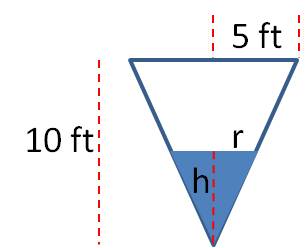The most complicated type of related rate problems for many students is when there is a variable and you have no information about its rate of change. In these problems, you will know how the variable is related to another variable with a known rate. You can then substitute the variable with the known rate in for the variable with the unknown rate. It sounds difficult, but with a little practice, you can master it.
Example: A water tower in the shape of an inverted cone is being filled at a rate of 2 cubic feet per minute. The tower is 10 feet tall and the radius of the base is 5 feet. How fast is the depth of the water changing when the depth is 4 feet?
Solution: First, we draw a picture. This drawing shows a cross section of the water tower, filled to a height of h.
The variables we know and seek are the following:
The variables suggest that the equation we need is the volume of a cone:
If we take the derivative now, we will end up with a dr/dt term but we are not given any information about how fast the radius is changing. We get around this problem by solving for r in terms of h and substituting. How are r and h related? Notice that the triangle of water in the drawing above is similar to the triangle of the whole water tower. This means we can set up the following relationship:
No matter how deep the water is at any time, the radius of the water surface will always be half the height of the water column. Substituting into our equation and simplifying:
Now that r has been eliminated, we can differentiate:
Plugging in values gives:
(Look for other tips on solving related rate problems on this website if you need help with other aspects of related rate problems.)

